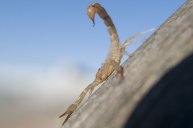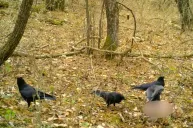Here's everything you ever wanted to know about the ubiquitous armadillo, like what the heck do they eat?
Armadillos aren't found everywhere, but in the areas where they live these unusual animals come in the form of the giant armadillo, nine-banded armadillo, and approximately 18 other species of the armored critter. In the United States, only the nine-banded species exists making it one of the most unique critters out there. For those who do not know, these critters are of the order Cingulata and are close relatives of anteaters and sloths from the rainforests of South America. Which explains some of their strange appearance
This armadillo has an interesting backstory, especially since some of them may only have seven, and others up to 11 bands on their armor creating another mystery in their species. While some may say that these armadillos can curl up into a ball, the truth is that only two specific species of dasypus novemcinctus can completely roll themselves up to try to escape predators.
Their name - armadillo comes from the Spanish language and roughly translates into "little armored one" This is in obvious reference to the presence of the bony, armor-like plates covering their body.
Range
According to the National Wildlife Federation, (NWF) Nine-banded armadillos are found mostly in the southeastern United States, but the fact is that the two species of armadillo have been expanding this range for over one hundred years or more. Many areas have the climate to support populations of this little creature and some have been seen as far north as Nebraska and Illinois.
Their preference is for warm, wet climates which have live forested or grassland habitats. Since populations of armadillos are ever on the increase, they can be seen along highways, paths, and in agricultural fields. This is how they often end up as roadkill like other commonly spotted dead animals like raccoons and opossums.
What Do Armadillos Eat?
As the FWS says, "These armadillos are generalist feeders and use their sense of smell to track down almost 500 different foods, most of which are invertebrates such as beetles, cockroaches, wasps, yellow jackets, fire ants, scorpions, spiders, snails, and white grubs."
It would seem that they are quite beneficial in some ways since they will consume many of the pests that cause a great deal of disturbance to humans such as fire ants. Although some of their other food sources are made up of small reptiles and amphibians as well as the eggs of reptiles and birds.
Breeding
The nine-banded armadillo is unique in that it almost always give birth to four identical quadruplets, an amazing feat in the natural world. Their armor helps to protect armadillos from predators, but at the time of their birth, the carapace of the offspring has not yet hardened. As you might guess, means the unprotected young are left extremely vulnerable. Still, if they can survive their youth, they have a long lifespan. These armadillos are known to live from 10 to 20 years in the wild, but older animals have ben found.
Armadillos and Leprosy
If you didn't already know, and you're seeing this for the first time, another really random fact is the armadillo is the only other living creature besides humans that can contract leprosy. As the CDC says,
"In the southern United States, some armadillos are naturally infected with the bacteria that cause Hansen's disease in people and it may be possible that they can spread it to people. However, the risk is very low and most people who come into contact with armadillos are unlikely to get Hansen's disease."
The CDC suggests that people avoid physical contact with armadillos if at all possible, even though the infection risk is low. Anyone who feels that they may have come into contact with one of these animals should follow up with their primary care physician to check for signs of the disease which can be treated.
Fun Facts

Getty Images: erniedecker
Armadillos have been a source of food for humans for many years, but not a very good one. The nine-banded armadillo was nicknamed the "poor man's pork" and "Hoover hog" by people who blamed President Hoover for their troubles during the Great Depression.
The nine-banded armadillo is said to be able to hold its breath for up to six minutes and it can even "walk" along the bottom of rivers; they are even great swimmers.
The Last Word
An armadillos diet can consist of many things from termites to larvae to earthworms. Although these omnivores will eat just about anything, even carrion in a pinch. They do quite well from Florida to Texas, but their burrowing is what causes a lot of ruckus among the farming community.
As for how to get rid of armadillos, there are plenty of tired and true methods. Some of these include restricting their food supply, in-ground electrical fencing, but one of the most effective ways to reduce their presence is by simply by adding some smell: they seem to just hate ammonia, mothballs, and vinegar.
They have poor eyesight but a keen sense of smell, strong legs, and a sticky tongue, but they do call for some wildlife damage management at some point. Armadillos aren't dangerous as they are docile and easily frightened, but they do a great deal of damage to foundations, gardens, and other human areas. As odd as they are, the armadillo is something of an iconic animal for Texas and surrounding states these days and we anticipate it'll be that way for quite some time.
Products featured on Wide Open Spaces are independently selected by our editors. However, when you buy something through our links, we may earn a commission.
Looking for a new way to display those antler sheds? Go to Rack Hub and use the coupon code Craiger. Be sure to follow my webpage, or on Facebook and YouTube.
NEXT: AMERICAN PADDLEFISH: PROFILING THE RELIC SPECIES
WATCH





